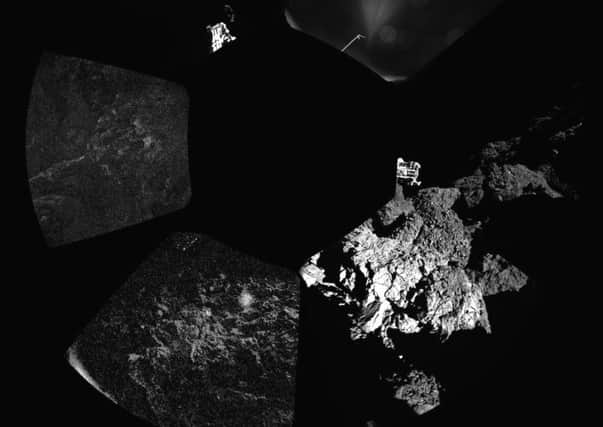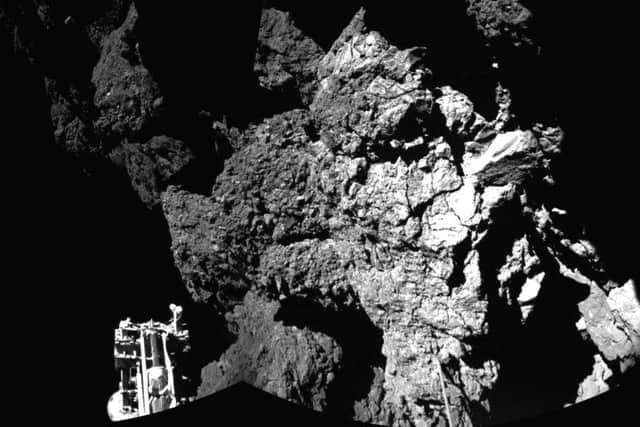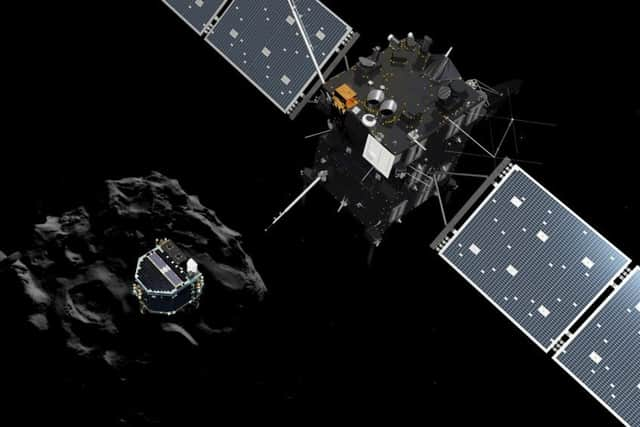Battery drain: Time runs out for Philae


But whether enough power remains in the craft’s depleting batteries to obtain scientific data from the samples is an unanswered question.
Philae is believed to be tilted to one side in the shadow of a crater wall. It is not receiving enough light to recharge its batteries using electricity generated by its solar panels.
Advertisement
Hide AdAdvertisement
Hide AdWith less than 24 hours before the European Space Agency (ESA) craft’s primary battery power runs out, scientists are actively considering taking a last-ditch gamble and “hopping” the lander to a sunnier spot.


In the ultra-low gravity, it might be possible to jump the probe with its landing gear, shift the craft by activating moving parts linked to its instruments.
Using the drill risked destabilising the probe but held out the promise of delivering valuable science.
ESA project manager Philippe Gaudon said Philae had successfully deployed its drill and bored 25 inches (10 inches) into the surface of comet 67P/Churyumov-Gerasimenko.
Advertisement
Hide AdAdvertisement
Hide Ad“So the mechanism has worked, but unfortunately we have lost the link and we have no more data,” he said.


Philae lander manager Dr Stephan Ulamec said it was not known whether there would be enough battery power to restore the communications link.
“Maybe the battery will be empty before we get contact again,” he added.
Earlier, British scientist Professor Ian Wright, lead investigator for Philae’s Ptolemy instrument, said mission controllers were actively considering hopping the craft.
Advertisement
Hide AdAdvertisement
Hide Ad“There is a slight worry that if you try to move something it might make things worse,” he said. “It might topple over. But clearly if you’re getting to the end there’s no harm in having a go.
“It’s a complete unknown but clearly we should be taking risks. There’s no point in not doing that.”
The dishwasher-sized craft made a dramatic landing on comet 67P/Churyumov-Gerasimenko on Wednesday after an epic 10-year, four billion-mile journey through space aboard the Rosetta mothership.
Two harpoons that were supposed to anchor Philae to the surface failed to deploy, and the probe bounced a kilometre (0.6 miles) into space, floating above the comet for nearly two hours. Eventually gravity drew it down and it bounced again, coming to rest close to the wall of a large crater more than half a mile from the original landing site.
Advertisement
Hide AdAdvertisement
Hide AdScientists believe it is positioned at an angle with one of its three spidery legs suspended in space.
The cliff-like crater wall has cast a dark shadow on the probe that is now the scientists’ greatest worry. Instead of the expected six or seven hours of sunlight per 12-hour day, Philae is only receiving one and a half.
It is still unclear precisely where the lander is, and how it is orientated.
“The working assumption is that it’s tilted,” said Prof Wright, of the Open University.
Advertisement
Hide AdAdvertisement
Hide Ad“There’s some talk about it having tumbled or something, but I don’t think that can be right because it would have caused more damage.”
Despite its rollercoaster landing, Philae’s radio antenna is operating normally and most of its package of 10 scientific instruments is functional.
Ptolemy is one of the instruments designed to analyse drill samples after they have been heated and vaporised in the probe’s laboratory ovens.
It has already been sending back data on dust and gas “sniffed” from the environment around the lander.
Advertisement
Hide AdAdvertisement
Hide AdWhile scientists try to save Philae, attention will also turn to Rosetta, which now has to manoeuvre from its post-separation path back into orbit.
Next year, as the comet grows more active, Rosetta will step further back and fly unbound “orbits”, making brief fly-bys to within five miles of the comet’s surface.
The comet will reach its closest point to the sun on August 13 next year at a distance of about 115 million miles, roughly between the orbits of Earth and Mars.
UK scientists are involved in 10 of the 21 experiments Rosetta will carry out during its £1 billion mission.
Advertisement
Hide AdAdvertisement
Hide AdBritish engineers have also made major contributions to the mission’s electrical, software and imaging systems.
Scientists hope the mission will shed new light on the origins of the solar system, the Earth, and even life.
Comets bombarding the early Earth are thought to have imported large amounts of water, as well as complex organic compounds.
Speaking at an online update briefing, Dr Ulamec said: “We have activated the drill. It started the drill but then we lost contact again.
Advertisement
Hide AdAdvertisement
Hide Ad“Whether it will actually take samples and we succeed in getting samples to ovens, we will know this evening.
“This will be very exciting because we are not sure whether the batteries still have enough energy so that we can transmit this data when we get the contact again.”
Rosetta, which relays Philae’s transmissions to Earth, is currently below the comet’s horizon and therefore unable to communicate with the lander.
Dr Ulamec said one option for re-positioning Philae that was under consideration was kicking it out by spinning the probe’s flywheel.
Advertisement
Hide AdAdvertisement
Hide AdThe flywheel, part of the landing gear, was used to stop the craft rotating as it neared the ground and was switched off after touchdown.
“That’s one idea, to spin up the flywheel and kick the lander somehow,” said Dr Ulamec. “We’re still thinking about this.”
He said there was no likelihood of the harpoons firing accidentally and there were no plans to attempt to deploy them.
Dr Ulamec said the first drill samples would be analysed by a German instrument, Cosac, rather than the UK’s Ptolemy.
Advertisement
Hide AdAdvertisement
Hide AdThis was because it consumed less energy and was more complementary to measurements made by Rosetta.
The state of the batteries will be revealed when an attempt is made to re-establish the radio link with Philae, said Dr Ulamec.
“If we have the possibility for a link and we don’t get any data, it’s probably because the battery is flat,” he said.
Rosetta project scientist Matt Taylor remained characteristically upbeat.
He said: “We’re at the cutting edge of science - science is being done. We haven’t got any results yet. But just wait and hang in there. The drill’s going down. This is going to be fantastic.”